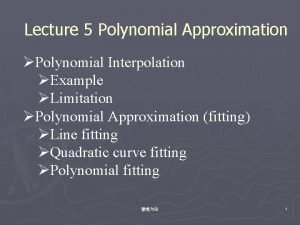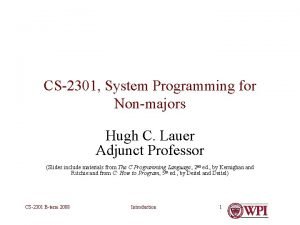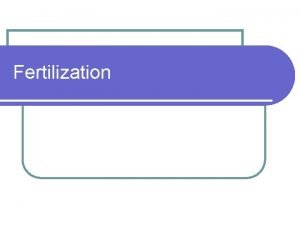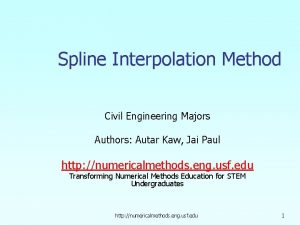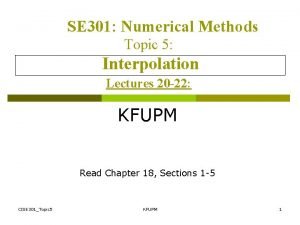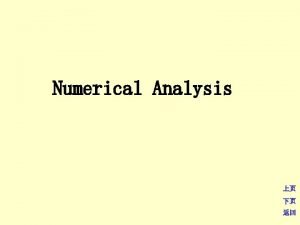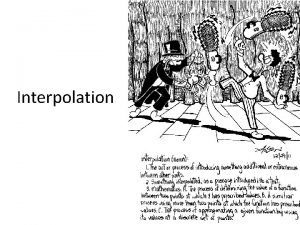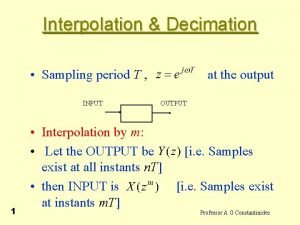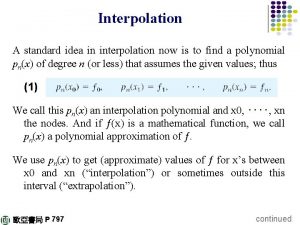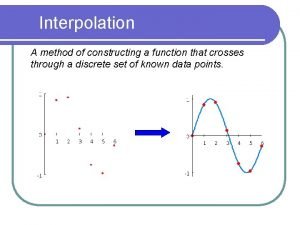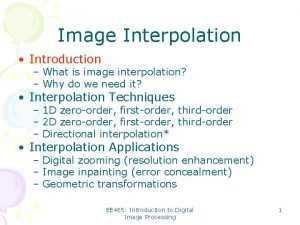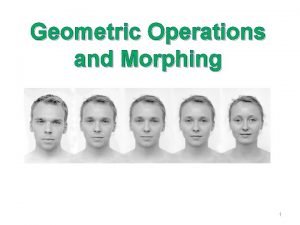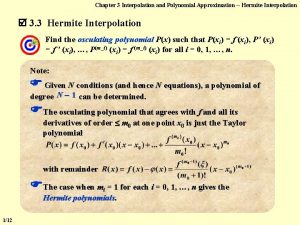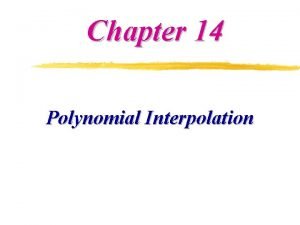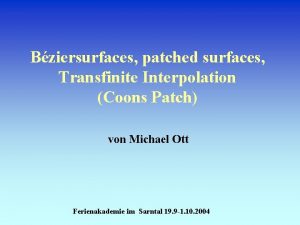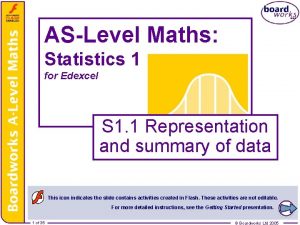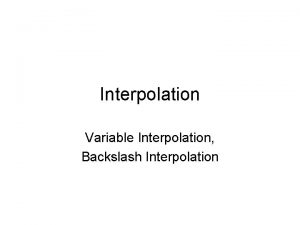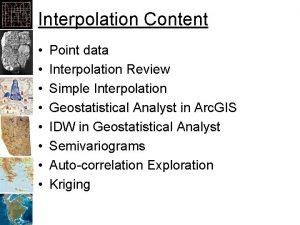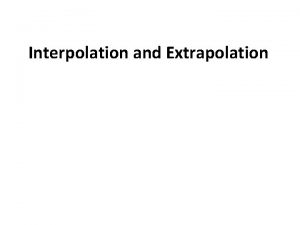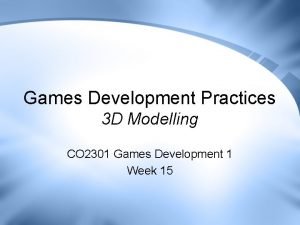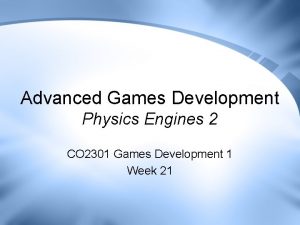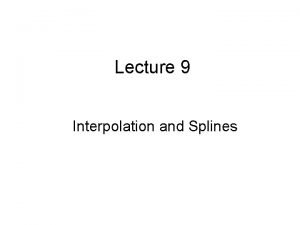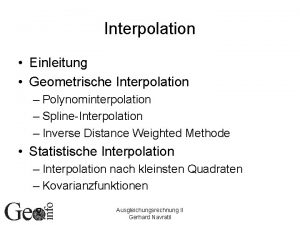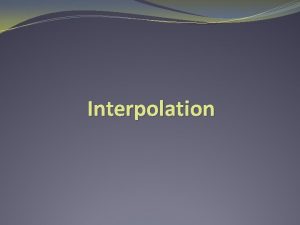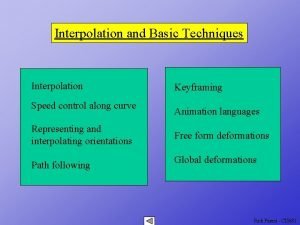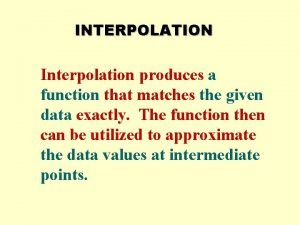CO 2301 Games Development 1 Week 12 Interpolation


































- Slides: 34

CO 2301 - Games Development 1 Week 12 Interpolation, Path Smoothing & Splines Gareth Bellaby 1

Topics 1. Introduction - Path Smoothing 2. Parametric line equations 3. Interpolation 4. Path Smoothing & Splines 2

Topic 1 Introduction - Path Smoothing 3

Path Smoothing • The path generated by the pathfinding algorithms are composed of unnatural looking straight lines and abrupt turns. This is true whichever representation is used. • Path Smoothing is about smoothing the path and making something more aesthetically pleasing. 4

Path Smoothing • We have a set of points. • We want to instead to have a curved path or line. • One way to do this is so employ a spline. A spline takes two or more points and draws a curve based on the location of the points. • The word spline is an architectural term- it was a flexible wooden rod used to draw out a curve, e. g. for a pillar section. • There are different types of spline. The curve they generate have different characteristics. 5

Topic 2 Parametric line equations 6

Parametric equation • A parametric equation is simply one that contains a parameter. • In this context, the parameter means a variable. • Two points are needed to calculate the equation for a line. 7

Parametric equation • One convention is to use t for the parameter. • All of the points lying along a line can be expressed using the following formula: • In practice you will express each of the x, y and z components separately, e. g. 8

Parametric equation • P 0 is the point where the line starts. • P 1 - P 0 is simply the vector (or slope) between two points. • t is a variable which ranges across all of the possible points along the line. 9

Example 10

Intervals • Note that the parametric line equation can be used to derive regular intervals along the line. • The half-way point is calculated if t = 0. 5. • The quarter-way point is calculated if t = 0. 25. 11

Example: mid-point 12

Example: quarter-point 13

Topic 3 Interpolation 14

Interpolation • Interpolation is the creation of new data points from a set of known points. • For example, a scatter of points on a graph. From the given points you can calculate the line which has the closest fit 15

Interpolation • The line could take different forms. For example: • a straight line which passes through all of the points • some kind of curve which appears to be a close fit but is allowed to miss the points 16

Interpolation • Interpolation is the operation whereby you capture the essence of a set of data whilst leaving out the noise. • Interpolation is carried out by creating a function. • A function "in mathematics, [is] an expression, rule, or law that defines a relationship between one variable (the independent variable) and another variable (the dependent variable). " Encyclopædia Britannica • So a function takes an input and calculates an output according to some mathematical rule or operation. 17

Interpolation • Set of points. Want to draw a line through them, but we want this to be a aesthetically pleasing curve. • Need to calculate points in between our known points. This method is know as interpolation. • Interpolation means to take a set of discrete points at given intervals and generate the continuous function that passes through the points. • Laurent will do interpolation with you in the context of animation. 18

Linear Interpolation • Linear interpolation is usual abbreviated to lerp. • By using the parametric line equation you can calculate any point along the line. • Often rearranged into the following form: 19

Polynomial interpolation • It is also possible interpolation. to use polynomial • A polynomial expression is an expression involving a sum of powers. • So simply interpolation using a polynomial. • Produces interesting curves, for example curves which are irregular, which perform abrupt changes in direction, or even form knots. 20

Topic 4 Path Smoothing & Splines 21

Path Smoothing • There are many ways to interpolate data. I will introduce a method of generating a curve called the Catmull-Rom spline. • I will quickly pass over how it does this, but essentially you generate tangents based on the position of the sample points. • For more details see Van Verthe section 9. 6 and Rabin, "A* Aesthetic Optimizations", Games Gems. 22

Catmull-Rom spline 23

Catmull-Rom spline • Need four points. • The curve is derived for the line between the second and third points. • The line is calculated as a sequence of discrete locations. • The calculation is carried out for each component of the four points. • Bicubic polynomial. 24

Catmull-Rom spline • Where A, B, C and D are: 25

Path Smoothing • As with parametric line equations, in practice you will express each of the x, y and z components separately (cf. slide 8 and the examples given on slides 10 - 13. ) 26

Example • Given 4 points (1, 2), (2, 4), (4, 3) and (5, 6). • Do the calculation first for x: 27

Example • Now plug this into the equation. • If we want the mid -point between B and C then t = 0. 5 28

Catmull-Rom spline • You don't need to derive all of the points of the curve. • An efficiency gain can be made by using predetermined intervals. This allows you to pre-calculate the value of t. • Quarter interval: • Half interval: • Three quarter interval: 29

Catmull-Rom spline • In order to derive the line between the second and third points (the middle) use all four points. • In order to derive the line between the first and second points (the first third) use the first points twice, i. e. p 1 and p 2 are the same. • In order to derive the line between the third and last points (the last third) use the last points twice, i. e. p 3 and p 4 are the same. 30

Characteristics of Catmull. Rom spline • The curve passes through all of the points. • It is reasonably efficient. • The line is continuous. 31

Bézier curve • There a number of other splines: Hermite splines, B-Splines, etc. • A commonly used one is the Bézier spline. • As with all of the splines, the Bézier spline uses polynomial interpolation. A cubic Bézier curve is give using the following forumula: 32

Characteristics of Catmull. Rom spline • The curve passes through all of the points. • It is reasonably efficient. • The line is continuous. 33

Characteristics of Bézier spline • The curve touches the first and last points. • The curve is within the convex hull of the control points. 34
 Spline interpolation vs polynomial interpolation
Spline interpolation vs polynomial interpolation Week by week plans for documenting children's development
Week by week plans for documenting children's development Dcm-2301
Dcm-2301 Znid-gpon-2301-eu
Znid-gpon-2301-eu Cs 2301
Cs 2301 Game 2301 belajar
Game 2301 belajar Game 2301
Game 2301 Game 2301
Game 2301 Cs 2301
Cs 2301 Hunger games chapter 15 questions and answers
Hunger games chapter 15 questions and answers Outdoor games and indoor games
Outdoor games and indoor games First week of development
First week of development Phase of fertilization
Phase of fertilization Civil interpolation
Civil interpolation Lagrange's interpolation formula
Lagrange's interpolation formula Define interpolation in numerical methods
Define interpolation in numerical methods Interpolation in numerical methods
Interpolation in numerical methods Extrapolation vs interpolation
Extrapolation vs interpolation Spline
Spline Interpolation and decimation
Interpolation and decimation Radial basis function interpolation matlab
Radial basis function interpolation matlab Newton's forward interpolation formula
Newton's forward interpolation formula Site:slidetodoc.com
Site:slidetodoc.com Interpolasi data
Interpolasi data Interpolation irr formula
Interpolation irr formula Matlab
Matlab Geometric operations
Geometric operations Interpolation economics
Interpolation economics Direct method of interpolation
Direct method of interpolation Interpolation direct method
Interpolation direct method Interpolation vs extrapolation math
Interpolation vs extrapolation math Cubic hermite interpolation
Cubic hermite interpolation Lagrange interpolation
Lagrange interpolation Coons patch
Coons patch Interpolation a level maths
Interpolation a level maths
